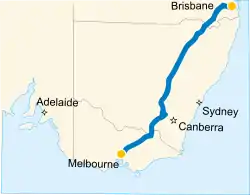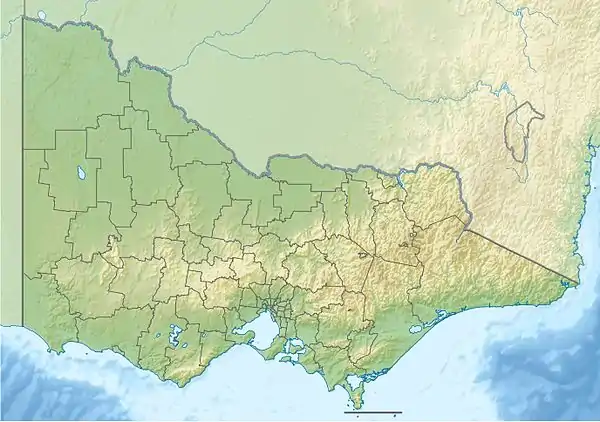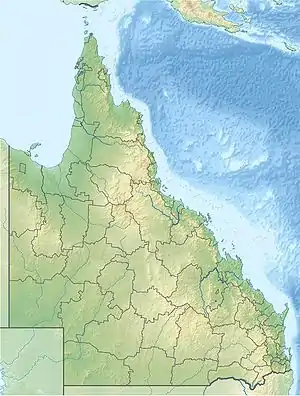| Inland Rail | |
|---|---|
 | |
 Inland Rail route alignment | |
| Overview | |
| Other name(s) |
|
| Status | Under construction |
| Owner | Australian Rail Track Corporation |
| Locale | Australia |
| Termini | |
| Website | inlandrail |
| Service | |
| Type | Heavy rail (freight) |
| Operator(s) | Open access |
| History | |
| Commenced | 2018 |
| Planned opening | 2027 |
| Technical | |
| Track length | 1,727 km (1,073 mi) |
| Number of tracks | 1 |
| Track gauge |
|
Inland Rail, also known as Inland Railway and previously Australian Inland Railway Expressway, is a 1727-kilometre (1073 mi) railway line under construction in Australia. Once complete, it will connect the ports of Melbourne and Brisbane along a new route west of the mountainous Great Dividing Range, bypassing the busy Sydney metropolitan area and allowing for the use of double-stacked freight trains. The route will also connect to the Sydney–Perth rail corridor, reducing journey times between Brisbane, Adelaide and Perth.
Construction of the line is divided into 13 projects, with 733 kilometres (455 mi) of new track to be built and 994 kilometres (618 mi) of existing track to be upgraded.[1][2]
History
Early proposals
In 1889, a proposed standard gauge and partly mixed gauge line from Brisbane via Rosewood, Warwick and Wallangarra shortened the distance between Brisbane and Sydney by 55 miles (89 km).[3]
In the 20th century, several proposals were made for an inland railway route connecting the east coast of Australia.[4] In 1915, Prime Minister Andrew Fisher proposed a "strategic railway" connecting the South Australian city of Port Augusta to Brisbane, with connections to the New South Wales railway network, at an estimated cost of A£6,500,000.[5] In 1979, TNT founder Ken Thomas proposed a route connecting Brisbane to Melbourne via Wallangarra, Orange and Albury, with possible connections to Adelaide and Perth.[6]
Later proposals
In 1995, Queensland Rail detailed a $1.289 billion (equivalent to $2.52 billion in 2022) proposal for an inland railway corridor connecting Brisbane and Melbourne.[7] New dual gauge track would follow the existing 1,067 mm (3 ft 6 in) narrow gauge Main Line to Toowoomba, the Western railway line to Wyreema and the Millmerran railway line to its terminus at Millmerran, with new track connecting to the Boggabilla railway line south of the New South Wales–Queensland border.[8]
The route would then have continued along the 1,435 mm (4 ft 8+1⁄2 in) standard gauge Mungindi railway line until Bellata, with a new line connecting the Coonamble railway line via Wee Waa before once again following existing track: the Main Western railway line to Narromine; the Parkes–Narromine railway line to Parkes; the Stockinbingal–Parkes railway line to Stockinbingal; the Lake Cargelligo railway line to Cootamundra; the Main Southern railway line to Albury; and the North East railway line to Melbourne.[8] A maximum line speed of 100 kilometres per hour (62 mph) would be in place for the corridor, with an additional $189 million (equivalent to $370.15 million in 2022) upgrade to existing track allowing for speeds of up to 160 kilometres per hour (99 mph) in sections.[7]
In 1996, the Bureau of Transport and Communications Economics (BTCE) released a working paper assessing the proposal. It found a new route would save ten hours journey time on the existing coastal route via Sydney, reducing the operating cost for operators from $23.16/tonne to $17.56/tonne,[9] but would facilitate only a small increase in grain production.[10][11]
In September 2005, the federal Department of Transport and Regional Services commissioned a feasibility study into a Brisbane–Melbourne railway link, outlining four possible 'sub-corridors' between Junee and Brisbane.[12] In May 2008, the newly elected Rudd government allocated $15 million to the Australian Rail Track Corporation (ARTC) to develop a route alignment following the Far Western sub-corridor as detailed in the 2006 study.[13][14] The corporation's preliminary analysis was released in May 2009, which showed that the cheapest version of the inland railway would cost $2.8 billion to build and would allow freight to be moved from Melbourne to Brisbane in just over 27 hours. Despite this, the analysis also found that, if operational by 2020, the project's costs would outweigh any economic benefits by up to $1.1 billion.[15]
The ARTC's final report was released in July 2010. The report recommended a route from Junee to Melbourne via Albury following the North East railway line, with the route from Moree to Brisbane to build along a new corridor through the Toowoomba range.[16] The report forecast a delivery cost of $3.688 billion, with track duplication works between Junee and Melbourne and capacity for double-stacked freight trains between Melbourne and Parkes already budgeted by the ARTC.[17]
Approval and funding
The Gillard government announced forward estimates of $300 million in the 2011 federal budget commencing 2014, with the Coalition committing to the funding following the election of the Abbott government in 2013.[18] A further $594 million was allocated to ARTC by the Turnbull government in the 2016 federal budget to purchase land for the project,[19] with an additional $8.4 billion in funding over seven years announced in the subsequent 2017 budget.[20]
In the 2020 federal budget, the Morrison government pledged $150 million in funding for additional grade separation works in New South Wales, conditional upon a further $37.5 million commitment from the New South Wales state government.[21]
Route
The proposed route will connect the rail yard at Tottenham, Victoria with the freight yards at Acacia Ridge and Bromelton in Queensland, using a combination of new and existing standard gauge and dual gauge track. Upgrades to existing track will facilitate the use of double-stacked container trains between the three yards.
Victoria

In Victoria, the Inland Rail route will follow the existing North East railway line and Albion–Jacana railway line alignment. Between Tottenham and Seymour the line is mostly single track with several crossing loops between 870 m (2,850 ft) and 6,800 m (22,300 ft) in length. The line north of Seymour is double track, with a connection to the Oaklands railway line at Benalla.[22]
Initial works on the corridor commenced in May 2020 as part of the $235 million North East Rail Line Upgrade,[23] with John Holland contracted to upgrade the track for line speeds up to 130 km/h (81 mph).[24][25] Additional works in the corridor include:
- Replacing or modifying 12 railway bridges between Beveridge and Albury.[26]
- Building new track and relocating platform 2 at Wangaratta.[27]
New South Wales

From Albury, the route continues along the Main South railway line to Illabo. Initial consultations on this section of the route commenced in 2018, with upgrades planned to 185 km (115 mi) of track.[28] 37 km (23 mi) of new track is planned to be built between Illabo and Stockinbingal, connecting the Main South railway line to the Stockinbingal–Parkes railway line and bypassing Cootamundra and the Bethungra Spiral.[29]
The route continues along the line to Parkes, with upgrades planned to 173 km (107 mi) of track.[30] A further 98.4 km (61.1 mi) of track has been upgraded between Parkes and Narromine, in addition to the construction of a new 5.3 km (3.3 mi) connection with the Broken Hill railway line west of Parkes allowing services to connect to Adelaide and Perth.[31]
Replace or modify nn overbridges between Albury and Junee.[26][32]
300 km (190 mi) of track between Narromine and Narrabri will be built along a new alignment, and is the longest stage of the project. A further 186 km (116 mi) of existing railway between Narrabri and North Star will be upgraded, with a bypass at Camurra to remove a long hairpin.[33]
Queensland

The sections of the route between the New South Wales—Queensland border and the termini at Bromelton and Acacia Ridge total 303 kilometres (188 mi) and will be built as dual gauge, improving services on both the interstate standard gauge and Queensland narrow gauge networks.
South-west of Yelarbon, the Inland Rail route joins the alignment of the South Western railway line where it extends to south of Inglewood, with a new alignment connecting the now-closed Millmerran line north-east of Millmerran.[34] New track will be built between Southbrook and Gowrie Junction, with the route bypassing Toowoomba to Helidon on a new line and then along an upgraded Western line as far east as Calvert and new line 53 km to Kagaru. The existing dual gauge North Coast line of NSW between Acacia Ridge and Bromelton will also be upgraded to allow for double-stacked freight containers.
Tunnels
There are three tunnels in Queensland, which allow for double-stack rail transport and dual gauge and single-track railway. These are:
- Teviot Range Tunnel Inland Railway 1100m
- Little Liverpool Range Tunnel Inland Railway 850m
- Toowoomba Range Tunnel Inland Railway 6000m
These tunnels replace the original narrow gauge only tunnels between Grandchester and Toowoomba with a faster and more maintainable alignment.
Construction
Chronology
In October 2018, INLink, a joint-venture between BMD Constructions and Fulton Hogan, was awarded a $310 million contract for stage 1 of the project between Parkes and Narromine.[35][36] Work on the Parkes–Narromine railway line and the new Broken Hill railway line connection commenced in December 2018.[37] More than 1,800 people were employed on the project, with works completed in September 2020.[38]
Opposition to construction
The Narrabri and Baradine Aboriginal Land Councils have stated their opposition to the Narromine to Narrabri section of the project, planned to be built on an alignment through the Pilliga forests which contain various Aboriginal heritage sites. A route through the Pilliga forests was announced by Minister for Infrastructure, Darren Chester, in November 2017, despite initial plans by the ARTC to build the line through surrounding farmland.[39][40]
Landholders and farmers have opposed several sections of the project on environmental grounds. In September 2017, Chester announced the Yelarbon to Gowrie section would be built through the Condamine River floodplain, which reached its highest recorded level in the 2010–11 Queensland floods.[34] As a consequence, the Inland Rail project was referred to the Senate Rural and Regional Affairs and Transport References Committee in 2019,[41] with the committee chair, Senator Glenn Sterle, critical of ARTC for a lack of consultation with communities along the alignment.[42] Although the ARTC reaffirmed the Yelarbon to Gowrie route would remain across the floodplain,[43] in June 2020, Deputy Prime Minister, Michael McCormack, ordered a review of the alignment.[44]
In July 2020, the New South Wales branch of the Country Women's Association, along with the NSW Farmers' Association, commenced legal proceedings against ARTC, seeking an independent hydrology review into the Narromine to Narrabri stage of the project.[45]
See also
- Adelaide–Darwin rail corridor, a similar north–south rail corridor connecting inland Australia
- Rail transport in Australia
- Advanced Train Management System, to be fitted to those sections not fitted with regular signalling such as centralized traffic control
- Railway tunnels in Queensland, Australia
- Main Line railway, Queensland § First tunnels
References
- ↑ "Project". Infrastructure Pipeline. Australia & New Zealand Infrastructure Pipeline. Archived from the original on 3 June 2020. Retrieved 13 June 2020.
- ↑ "Inland Rail Alignment". Inland Rail. Australian Rail Track Corporation. Archived from the original on 26 February 2021. Retrieved 12 September 2020.
- ↑ "Construction of Railway - upon the 4 feet 8½-inch Gauge". Logan Witness. Vol. VIII, no. 398. Queensland, Australia. 5 December 1885. p. 3. Archived from the original on 23 July 2022. Retrieved 24 December 2020 – via National Library of Australia.
- ↑ Wilson, Alex.; Robinson, H. E. C. (1909), "1 map ; 30 x 26.5 cm. + accompanying diagram.", Part of Australia showing transcontinental railways and state connections, [Sydney?: H.E.C. Robinson], nla.obj-231830146, archived from the original on 23 July 2022, retrieved 12 September 2020 – via Trove
- ↑ "Strategic Railway". The Argus (Melbourne). No. 21, 401. Victoria, Australia. 27 February 1915. p. 9. Archived from the original on 23 July 2022. Retrieved 12 September 2020 – via National Library of Australia.
- ↑ Thomas, Ken (10 May 1979). "Making our railways pay". Sydney Morning Herald. p. 7.
- 1 2 Bureau of Transport and Communications Economics 1996, pp. 5–6.
- 1 2 Bureau of Transport and Communications Economics 1996, pp. 6–7.
- ↑ Bureau of Transport and Communications Economics 1996, p. 8.
- ↑ Bureau of Transport and Communications Economics 1996, p. 21.
- ↑ Bureau of Transport and Communications Economics 1996, p. 55.
- ↑ Ernst & Young 2006, p. 5.
- ↑ Albanese, Anthony (21 May 2008). "Inland rail alignment study underway". Australian Labor Party (Press release). Archived from the original on 5 October 2009.
- ↑ Grimson, Ken (20 August 2008). "Economics will decide inland rail route: ARTC". The Daily Advertiser. Archived from the original on 15 August 2011.
- ↑ Davis, Mark (7 May 2009). "Rail sums do not add up, says study". The Sydney Morning Herald. Archived from the original on 11 May 2009. Retrieved 11 May 2009.
- ↑ Australian Rail Track Corporation 2010, pp. 31–33.
- ↑ Australian Rail Track Corporation 2010, pp. 53.
- ↑ Truss, Warren; Emerson, Scott (28 August 2013). "Inland rail – the future of freight". Liberal Party of Australia (Press release). Archived from the original on 31 August 2013. Retrieved 12 September 2020.
- ↑ Barbour, Lucy (3 May 2016). "Government to spend $594 million buying land for Inland Rail line linking Brisbane and Melbourne". ABC Rural. Australian Broadcasting Corporation. Archived from the original on 11 February 2021. Retrieved 12 September 2020.
- ↑ Kotsios, Natalie (9 May 2017). "Budget 2017: Inland rail funding of $8.4 billion promised". The Weekly Times. Archived from the original on 16 January 2018. Retrieved 12 September 2020.
- ↑ "Federal Budget 2020: $150 million investment in additional grade separations of Inland Rail alignment in NSW". Moree Champion. 6 October 2020. Archived from the original on 17 October 2020. Retrieved 12 October 2020.
- ↑ "North East SG Line". Vicsig. Archived from the original on 1 September 2021. Retrieved 14 September 2020.
- ↑ Ruppert, Simon (18 March 2020). "ARTC work to get NE line up to scratch". The Corowa Free Press. Archived from the original on 23 July 2022. Retrieved 12 September 2020.
- ↑ "John Holland wins contract for Australian rail upgrade". The Construction Index. 10 December 2019. Archived from the original on 12 August 2020. Retrieved 12 September 2020.
- ↑ "Economy boost from rail works". Wangaratta Chronicle. 12 February 2020. Archived from the original on 8 August 2020. Retrieved 12 September 2020.
- 1 2 "Overbridges". Archived from the original on 28 June 2022. Retrieved 23 July 2022.
- ↑ Morgan, Shana (23 September 2018). "Rejig for 'tricky' inland rail works in Wangaratta on track for approval, as ARTC arrives for consultation in Albury". The Border Mail. Archived from the original on 29 August 2021. Retrieved 14 September 2020.
- ↑ Horn, Emma (13 September 2018). "Inland Rail project Illabo to Albury community consultations Australian Rail Track Corporation". Junee Southern Cross. Archived from the original on 9 November 2019. Retrieved 12 September 2020.
- ↑ "ARTC Inland Rail through Junee nears construction". Junee Southern Cross. 31 July 2019. Archived from the original on 29 August 2021. Retrieved 12 September 2020.
- ↑ "Businesses urged to register interest in Stockinbingal to Parkes section of Inland Rail". Parkes Champion-Post. 26 January 2020. Archived from the original on 27 January 2020. Retrieved 12 September 2020.
- ↑ "68km of rail in place between Parkes and Narromine". Parkes Champion-Post. 21 April 2020. Archived from the original on 11 May 2020. Retrieved 12 September 2020.
- ↑ "Albury to Illabo – Albury package project fact sheet - Inland Rail". 14 September 2023. Retrieved 8 October 2023.
- ↑ "Final load of concrete sleepers and rail delivered to Narrabri to North Star section of Inland Rail". Moree Champion. 27 August 2020. Archived from the original on 21 March 2022. Retrieved 12 September 2020.
- 1 2 Schwartz, Dominique; Blucher, Alexandra (21 September 2017). "Inland railway to go across Queensland floodplain despite warning 'lives could be at risk'". ABC News. Archived from the original on 22 September 2020. Retrieved 12 October 2020.
- ↑ "ARTC and INLink sign $300 million construction contract for Parkes to Narromine section of Inland Rail". Parkes Champion-Post. 23 October 2018. Archived from the original on 29 August 2021. Retrieved 17 September 2020.
- ↑ "INLink celebrates official commencement of Inland Rail project". BMD Constructions (Press release). 13 December 2018. Archived from the original on 23 March 2020. Retrieved 17 September 2020.
- ↑ Carter, Mark (19 December 2018). "Australia launches Inland Rail construction". International Railway Journal. Archived from the original on 28 August 2021. Retrieved 17 September 2020.
- ↑ "Inland Rail first phase completed". Railway Gazette International. 17 September 2020. Archived from the original on 17 September 2020. Retrieved 17 September 2020.
- ↑ Schwartz, Dominique; Blucher, Alexandra (10 December 2017). "Tension on the track". ABC News. Archived from the original on 26 October 2020. Retrieved 12 October 2020.
- ↑ Schwartz, Dominique; Blucher, Alexandra (11 December 2017). "Inland rail: Here's what you need to know about the $10 billion project". ABC News. Archived from the original on 29 October 2020. Retrieved 12 October 2020.
- ↑ Coughlan, Matt (17 September 2019). "Inland rail under microscope from inquiry". The Canberra Times. Archived from the original on 16 October 2020. Retrieved 12 October 2020.
- ↑ Ruddick, Baz; Bradfield, Elly (29 January 2020). "Inland Rail Senate inquiry gets flood of community concerns about building line through floodplain". ABC News. Archived from the original on 22 August 2020. Retrieved 12 October 2020.
- ↑ Phelps, Mark (12 March 2020). "Inland Rail is staying on the Condamine floodplain says ARTC". Queensland Country Life. Archived from the original on 12 October 2020. Retrieved 12 October 2020.
- ↑ Bradfield, Elly (3 June 2020). "Trouble on Condamine floodplain track in southern Queensland with review of new inland rail route ordered". ABC Southern Queensland. ABC News. Archived from the original on 8 August 2020. Retrieved 12 October 2020.
- ↑ Bernasconi, Amelia; Condon, Michael (20 July 2020). "Inland rail project subject to legal action by NSW Farmers' Association and CWA over hydrology modelling". NSW Country Hour. Australian Broadcasting Corporation. Archived from the original on 31 July 2020. Retrieved 12 September 2020.
Bibliography
- Economic effects of a Brisbane-Melbourne inland railway (PDF) (Report). Canberra: Bureau of Transport and Communications Economics. March 1996. 0 642 24518 5. Archived (PDF) from the original on 24 March 2020. Retrieved 12 September 2020.
- Melbourne–Brisbane Inland Rail Alignment Study: Final report (PDF) (Report). Canberra: Australian Rail Track Corporation. July 2010. Archived (PDF) from the original on 24 October 2020. Retrieved 12 September 2020.
- North–South Rail Corridor Study Executive Report (PDF) (Report). Canberra: Ernst & Young. 30 June 2006. Archived (PDF) from the original on 5 March 2020. Retrieved 12 September 2020.